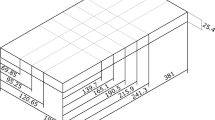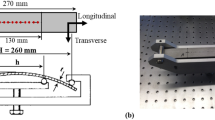Abstract
Most validation studies of mechanical strain relaxation (MSR) methods for residual stress measurement rely on using the saw-tooth residual stress distribution resulting from four point bending and elastic–plastic deformation. Validation studies using simple applied stress profiles in rectangular steel beams are used in this work, together with beams subjected to elastic–plastic bending. Two MSR methods are explored, deep-hole drilling (DHD) and incremental centre hole drilling (ICHD). As well as a series of experiments, finite element analyses are conducted to determine the accuracy in the inversion of measured deformation to reconstruct stress. The validation tests demonstrated that apart from the applied stresses, the initial residual stresses also contribute even when samples are expected to be stress free. The uncertainty in measurement for the two MSR methods is determined, with the uncertainty in near surface measurement found to be significantly larger than uncertainty for interior measurement. In simple loading cases (and simple stress profiles) the uncertainty in measurement and hence the degree of validation is shown to be within about ±50 MPa for steel for “known” stress up to about 140 MPa. However, if the residual stress distribution is more complex there arises increased uncertainty in the predicted residual stress and lack of confidence between measurements methods.













Similar content being viewed by others
References
Noyan IC, Cohen JB (1987) Measurement by diffraction and interpretation. Springer, New York
Withers PJ, Bhadesia HKDH (2001) Residual stress - part 1 – measurement techniques. Mater Sci Technol 17(01):355–365
Kandil FA, Lord JD, Fry AT, Grant PV (2004) “A review of residual stress measurement methods - a guide to selection”, NPL Report MATC (A) Teddington, Middlesex, UK, 2001
George D, Kingston E, Smith DJ (2002) Measurement of through-thickness stresses using small holes. J Strain Anal 37:125–139
Stefanescu D, Truman CE, Smith DJ, Whitehead PS (2006) Improvements in residual stress measurement by the incremental centre hole drilling technique. Exp Mech 46:417–427
Smith DJ, Bouchard PJ, George D (2000) Measurement and prediction of residual stresses in thick-section steel welds. J Strain Anal 35:287–305
Prime MB (1999) Residual stress measurement by successive extension of a slot: the crack compliance method. Appl Mech Rev 52(2):75–96
Prime MB (2001) Cross-sectional mapping of residual stresses by measuring the surface contour after a cut. J Eng Mater Technol 123:162–168
Hill MR, Nelson DV (1995) The inherent strain method for residual stress determination and its application to a long welded joint, vol 318. ASME, PVP, New York, pp 343–352
Schajer GS, Prime MB (2006) Use of inverse solutions for residual stress measurement. J Eng Mater Technol 128(3):375–382
Gleser LJ (1998) Assessing uncertainty in measurement. Stat Sci 13(3):277–290
Leggatt RH, Smith DJ, Smith SD, Faure F (1996) Development and experimental validation of the deep hole method for residual stress measurement. J Strain Anal 31:177–186
Ezeilo AN, Webster GA (2000) Neutron diffraction analysis of the residual stress distribution in a bent bar. J Strain Anal Eng Des 35(4):235–246
Webster GA (2000) Neutron diffraction measurement of residual stress in a shrink-fit ring and plug, VAMAS Report no 38
Gnaupel-Herold T, Prask HJ, Clark AV, Hehman CS, Nguyen TN (2000) A comparison of neutron and ultrasonic determinations of residual stress. Mater Sci Technol 11:436–444
Stacey A, MacGillivary HJ, Webster GA, Webster OJ, Ziebeck KRA (1985) Measurement of residual stresses by neutron diffraction. J Strain Anal 20(2):93–100
Venter AM, de Swardt RR, Kyriacou S (2000) Comparative measurements on autofrettaged cylinders with large Bauschinger reverse yielding zones. J Strain Anal 35:459–469
Cho JR, Conlon KT, Reed RC (2003) Residual stresses in an Electron Beam Weld of Ti-834 Characterisation and Numerical Modelling. Metall Mater Trans A 34A:2935–2946
Ficquet X, Smith DJ, Truman CE, Kingston EJ, Dennis RJ (2009) Measurement and prediction of residual stress in a bead-on-plate weld benchmark specimen. Int J Press Vessel Pip 86:20–30
Nadri B, Bouchard PJ, Truman CE, Smith DJ (2007) “Statistical analysis of experimental and numerical weld residual stresses”, Proceedings of the ASME Pressure Vessels and Piping Conference, San Antonio, Texas, USA, CD
Carston O, Wimpory R, Neov D (2009) Residual stress measurement by neutron diffraction in a single bead on plate weld - influence of instrument and measurement settings on the scatter of the results. Mater Sci Forum 638–642:2452–2457
Schajer GS (1988) Measurement of Non-uniform residual stresses using the hole drilling method. Part I - stress calculation procedures. J Eng Mater Technol 110:338–343
BIPM, IEC, IFCC, ISO, IUPAC, IUPAP, OIML (1995) Guide to the expression of uncertainty in measurement (GUM). ISO, Geneva
Menditto A, Patriarca M, Magnusson B (2007) Understanding the meaning of accuracy, trueness and precision. Accred Qual Assur 12:45–47
Schajer GS, Altus E (1996) Stress calculation error analysis for incremental hole-drilling residual stress measurements. J Eng Mater Technol 118(1):120–126
Goudar DM, Truman CE, Smith DJ (2011) Evaluating uncertainty in residual stress measured using the deep-hole drilling technique. Strain 47(1):62–74
Goudar DM (2011) “Quantifying uncertainty in residual stress measurement using hole drilling technique”, PhD thesis, Department of Mechanical Engineering, University of Bristol, UK
Fitzpatrick ME, Lodini A (2003) “Analysis of residual stress by diffraction using neutron and synchrotron radiation ”, Taylor & Francis, London
Zuccarello B (1999) Optimal calculation steps for the evaluation of residual stress by the incremental hole-drilling method. Exp Mech 39:117–124
Gere JM (2004) “Mechanics of materials”, 6th Edition, Thomson Learning Inc.
Dowling NE (1999) “Mechanical behaviour of materials-engineering methods for deformation, fracture and fatigue”, Second edition, Prentice Hall
ABAQUS, VERSION 6.9, Dassault Systemes UK Ltd. http//www.simulia.com
ASTM-E837-08 (2008) “Standard test method for determining residual stresses by the hole-drilling strain-gage method,” ASTM International
Grant PV, Lord PD, Whitehead PS (2002) The measurement of residual stresses by the incremental hole drilling technique, measurement good practice guide 53. National Physical Laboratory, UK
Information on http://www.vishaymeasurementgroup.com.
Stefanescu D, Truman CE, Smith DJ (2004) An integrated approach for measuring the near-surface and subsurface residual stress in engineering components. J Strain Anal 39:483–497
Schajer GS, Prime MB (2007) Residual stress solution extrapolation for the slitting method using equilibrium constraints. J Eng Mater Technol 129(2):226–232
Hodgson DZL (2011) “Residual stress measurement across different length scales”, PhD Thesis, University of Bristol
Nowell D, Tochilin S, Hills DA (2000) Measurement of residual stresses in beams and plates using the crack compliance technique. J Strain Anal 35(4):277–285
Nadri B, Bouchard PJ, Smith M, Truman CE, Smith DJ (2010) Modelling and statistical treatment of residual stress distributions in an edge welded stainless steel beam. Strain. doi:10.1111/j.1475-1305.2009.00718
Author information
Authors and Affiliations
Corresponding author
Rights and permissions
About this article
Cite this article
Goudar, D.M., Smith, D.J. Validation of Mechanical Strain Relaxation Methods for Stress Measurement. Exp Mech 53, 267–286 (2013). https://doi.org/10.1007/s11340-012-9638-9
Received:
Accepted:
Published:
Issue Date:
DOI: https://doi.org/10.1007/s11340-012-9638-9




